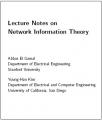A Short Course in Information Theory
by David J. C. MacKay
Publisher: University of Cambridge 1995
Description:
Is it possible to communicate reliably from one point to another if we only have a noisy communication channel? How can the information content of a random variable be measured? This course will discuss the remarkable theorems of Claude Shannon, starting from the source coding theorem, which motivates the entropy as the measure of information, and culminating in the noisy channel coding theorem. Along the way we will study simple examples of codes for data compression and error correction.
Download or read it online for free here:
Download link
(multiple PDF,PS files)
Similar books
 Error-Correction Coding and Decoding
Error-Correction Coding and Decodingby Martin Tomlinson, et al. - Springer
This book discusses both the theory and practical applications of self-correcting data, commonly known as error-correcting codes. The applications included demonstrate the importance of these codes in a wide range of everyday technologies.
(6672 views)
 Quantum Information Theory
Quantum Information Theoryby Renato Renner - ETH Zurich
Processing of information is necessarily a physical process. It is not surprising that physics and the theory of information are inherently connected. Quantum information theory is a research area whose goal is to explore this connection.
(12304 views)
 A primer on information theory, with applications to neuroscience
A primer on information theory, with applications to neuroscienceby Felix Effenberger - arXiv
This chapter is supposed to give a short introduction to the fundamentals of information theory, especially suited for people having a less firm background in mathematics and probability theory. The focus will be on neuroscientific topics.
(8778 views)
 Lecture Notes on Network Information Theory
Lecture Notes on Network Information Theoryby Abbas El Gamal, Young-Han Kim - arXiv
Network information theory deals with the fundamental limits on information flow in networks and optimal coding and protocols. These notes provide a broad coverage of key results, techniques, and open problems in network information theory.
(14382 views)